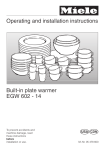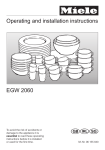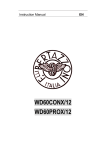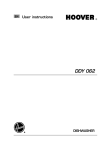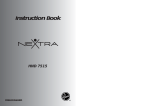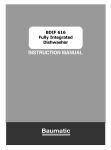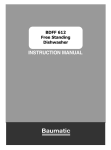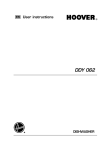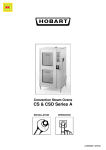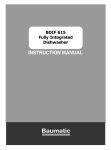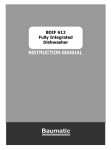Download Miele EGW 601-14 Operating instructions
Transcript
Operating and Installation instructions Built-in plate warmer EGW 601-14/EGW 601-29, EGW 602-14/EGW 602-29 EGW 604-14/EGW 604-29 It is essential to read these instructions before installing or using the machine, to avoid the risk of accident, or damage to the machine. GZWOXHr M.-Nr. 05 431 811 Contents Description of the appliance . . . . . . . . . . . . . . . . . . . . . . . . . . . . . . . . . . . . . . . . . 3 Caring for our environment. . . . . . . . . . . . . . . . . . . . . . . . . . . . . . . . . . . . . . . . . . 4 Warning and Safety instructions . . . . . . . . . . . . . . . . . . . . . . . . . . . . . . . . . . . . . 5 Using the plate warmer . . . . . . . . . . . . . . . . . . . . . . . . . . . . . . . . . . . . . . . . . . . . . 8 Functions . . . . . . . . . . . . . . . . . . . . . . . . . . . . . . . . . . . . . . . . . . . . . . . . . . . . . . . . . 8 Control area . . . . . . . . . . . . . . . . . . . . . . . . . . . . . . . . . . . . . . . . . . . . . . . . . . . . . . . 8 Selecting a temperature . . . . . . . . . . . . . . . . . . . . . . . . . . . . . . . . . . . . . . . . . . . 8 Switching on the appliance . . . . . . . . . . . . . . . . . . . . . . . . . . . . . . . . . . . . . . . . 9 Capacity . . . . . . . . . . . . . . . . . . . . . . . . . . . . . . . . . . . . . . . . . . . . . . . . . . . . . . . . . 9 EGW 60x - 14 . . . . . . . . . . . . . . . . . . . . . . . . . . . . . . . . . . . . . . . . . . . . . . . . . . 10 EGW 60x - 29 . . . . . . . . . . . . . . . . . . . . . . . . . . . . . . . . . . . . . . . . . . . . . . . . . . 10 Heating up times . . . . . . . . . . . . . . . . . . . . . . . . . . . . . . . . . . . . . . . . . . . . . . . . . . 11 Hints on using the plate warmer . . . . . . . . . . . . . . . . . . . . . . . . . . . . . . . . . . . . . . 11 Cleaning and care . . . . . . . . . . . . . . . . . . . . . . . . . . . . . . . . . . . . . . . . . . . . . . . . 12 Appliance front and control panel . . . . . . . . . . . . . . . . . . . . . . . . . . . . . . . . . . . . . 12 Mat with non-slip surface. . . . . . . . . . . . . . . . . . . . . . . . . . . . . . . . . . . . . . . . . . . . 13 Correcting minor faults . . . . . . . . . . . . . . . . . . . . . . . . . . . . . . . . . . . . . . . . . . . . 14 After sales service . . . . . . . . . . . . . . . . . . . . . . . . . . . . . . . . . . . . . . . . . . . . . . . . 15 Electrical connection . . . . . . . . . . . . . . . . . . . . . . . . . . . . . . . . . . . . . . . . . . . . . 16 Building-in combinations . . . . . . . . . . . . . . . . . . . . . . . . . . . . . . . . . . . . . . . . . . 19 EGW 60x - 14 . . . . . . . . . . . . . . . . . . . . . . . . . . . . . . . . . . . . . . . . . . . . . . . . . . . . . 19 EGW 60x - 29 . . . . . . . . . . . . . . . . . . . . . . . . . . . . . . . . . . . . . . . . . . . . . . . . . . . . . 21 Building in the plate warmer . . . . . . . . . . . . . . . . . . . . . . . . . . . . . . . . . . . . . . . . 22 Aligning the front of the plate warmer. . . . . . . . . . . . . . . . . . . . . . . . . . . . . . . . 23 2 Description of the appliance a On/Off switch (lights up) b Temperature control c Warming drawer d Non-slip mat e Rail f Indicator light on the appliance front 3 Caring for our environment Disposal of the packing material The transport and protective packing has been selected from materials which are environmentally friendly for disposal and can normally be recycled. Ensure that any plastic wrappings, bags etc. are disposed of safely and kept out of the reach of babies and young children. Danger of suffocation! Rather than just throwing these materials away, please ensure they are offered for recycling. 4 Disposal of your old appliance Old appliances contain materials which can be recycled. Please contact your dealer, your local waste collection centre or scrap merchant about potential recycling schemes. Ensure that the appliance presents no danger to children while being stored for disposal. See the appropriate advice in the "Warning and safety instructions". Warning and Safety instructions Correct usage This appliance complies with all relevant legal safety requirements. Improper use of the appliance can, however, present a risk of both personal injury and material damage. Before installation and before using the appliance for the first time, read the operating instructions carefully. They contain important notes on safety, on the installation, operation and care of the appliance. This way you will avoid the risk of accidents and damage to the appliance. The Miele plate warmer is available in two different heights for building-in in conjunction with Miele appliances. See section "Building-in combinations" for details. The appliance is intended for domestic use for heating plates, crockery and dishes. Any other usage is at the owner’s risk and could be dangerous. The manufacturer cannot be held responsible for damage caused by improper use of the appliance. It is essential to read the operating and installation instructions for any other appliance which is fitted in combination with the plate warmer. The appliance is not intended for use by young children or infirm persons without supervision. Young children should be supervised to ensure that they do not play with the appliance. Keep these instructions in a safe place and pass them on to any future user. 5 Warning and Safety instructions Technical safety Before connecting the appliance to the mains supply make sure that the voltage and frequency correspond to the rating on the data plate, otherwise the appliance could be damaged. Consult a competent person if in doubt. The electrical safety of this appliance can only be guaranteed when continuity is complete between the appliance and an effective earthing system, which complies with local and national safety regulations. It is most important that this basic safety requirement is tested by a qualified electrician. The manufacturer cannot be held responsible for the consequences of an inadequate earthing system (e.g. electric shock). This appliance must only be operated as a built-in appliance. This is necessary to ensure that all electrical components are shielded. Never open the casing of the appliance. Tampering with electrical connections or components and mechanical parts is highly dangerous to the user and can cause operational faults. 6 Installation work and repairs may only be carried out by a suitably qualified and competent person in accordance with national and local safety regulations. Repairs and other work by unqualified persons could be dangerous. The manufacturer cannot be held responsible for unauthorised work. The appliance is only completely isolated from the electricity supply when: – it is switched off at the wall socket – or the mains fuse is withdrawn Ensure that current is not supplied to the appliance while maintenance or repair work is being carried out. Do not connect the appliance to the mains electricity supply by an extension lead. Extension leads do not guarantee the required safety of the appliance, (e.g danger of overheating). This equipment is not designed for maritime use or for use in mobile installations such as caravans, aircraft etc. However, it may be suitable for such usage subject to a risk assessment of the installation being carried out by a suitably qualified engineer. Warning and Safety instructions Use The interior of the plate warmer drawer can reach temperatures of up to about 80 °C depending on the setting selected and how long the drawer has been switched on for. Using heat-resistant oven gloves is recommended when removing crockery. Do not let children access the appliance or its controls. Supervise its use by the elderly or infirm. The appliance can get hot in use. Danger of burning if the appliance were to be switched on inadvertently. Ensure that older children understand clearly how the appliance works before allowing them to use it. Do not use the plate warmer to re-heat, cook or keep food or drinks warm. The condensation from food / drinks could lead to moisture damage in the appliance. Do not lean or sit on an open warming drawer. This would damage the telescopic runners. The drawer can hold a maximum of 25 kg. Do not store any plastic containers, household foils and wraps or any inflammable objects in the warming drawer. They could melt or catch fire when the appliance is switched on. Under no circumstances use a steam cleaner to clean this appliance. The steam could attack the electrical components and cause a short circuit. In countries which may be subject to infestation by cockroaches or other vermin, pay particular attention to keeping the appliance and its surroundings in a clean condition at all times. Any damage which might be caused by cockroaches or other vermin will not be covered by the appliance guarantee. Disposal of your old appliance Before discarding an old appliance switch off and disconnect it from the power supply. Cut off and render any plug useless. Cut off the cable directly behind the appliance to prevent misuse. This should be done by a competent person. Ensure that the appliance presents no danger to children while being stored for disposal. The manufacturer cannot be held liable for damage caused by non-compliance with these Warning and Safety instructions. Do not use the appliance to heat up the room. Due to the high temperatures radiated, objects left near the appliance could catch fire. 7 Using the plate warmer Functions Control area The plate warmer is intended exclusively for heating crockery. Do not use the appliance to re-heat, cook or keep food or drinks warm. The condensation from the food / drinks could lead to moisture damage in the appliance. The appliance operates with a hot air system. A fan distributes the heat around the drawer. The hot air circulated heats up all the plates quickly and evenly. A protective grille prevents any contact with the heating element and fan. The rail in the drawer separates the control panel, heating element and fan from the rest of the drawer. This prevents plates from being placed too near the control panel and geting damaged when the drawer is pushed in. The floor of the plate drawer is fitted with a non-slip mat to prevent plates and dishes sliding about when the drawer is opened and closed. The controls consist of the temperature control and the On / Off switch. These are only visible when the drawer is open. Selecting a temperature The temperature control is used to adjust the temperature setting. Only turn the temperature control in a clockwise direction and then back again. Stop when you feel a resistance. Forcing the control past this point will damage it. The heating will switch off automatically when the temperature selected is reached. It will switch back on again as soon as the temperature drops below this level. 8 Using the plate warmer A temperature range of between approx. 30 and 80 °C can be set. Items to be heated can be divided into two general groups: – Cups / glasses – Serving dishes / plates Recommended temperatures for pre-heating: – approx. 40 °C for cups or glasses. A hot drink placed in a cup warmed to this temperature will cool down more slowly, while the cup itself can be touched easily (i.e. it is not too hot). – approx. 60 °C for serving dishes or plates. Food will stay hot for a long time if it is placed on plates heated to this temperature and the plates will not be too hot to hold when serving. The temperatures settings are shown as symbols rather than individual °C. Each symbol represents the best setting for the group shown: – b: for cups and glasses – r: for serving dishes, bowls and plates Switching on the appliance The appliance is switched on using the On / Off switch. To switch on: ^ Press the On / Off switch. The switch will light up. When the drawer is closed the indicator on the front of the appliance lights up to show the appliance is switched on. Capacity The plate warmer is available in two different heights: – EGW 60x - 14: 141 mm high. – EGW 60x - 29: 289 mm high. The height determines the capacity of the appliance. The following loading examples are given as a guide only. The quantity which can be loaded will depend to a great extent on the type and size of your own crockery. The maximum load for both models is 25 kg. 9 Using the plate warmer EGW 60x - 14 EGW 60x - 29 – Crockery for 6 people: 6 dinner plates Ø 28 cm 6 soup bowls Ø 10 cm 1 dish Ø 22 cm 1 dish Ø 19 cm 1 dish Ø 17 cm 2 large plates 36 cm – Crockery for 12 people: 12 dinner plates Ø 28 cm 2 dishes Ø 22 cm 2 dishes Ø 19 cm 2 dishes Ø 17 cm 2 large plates 36 cm or one of the following or one of the following – 20 dinner plates Ø 28 cm – 40 dinner plates Ø 28 cm – 36 soup bowls Ø 22 cm – 60 soup bowls Ø 22 cm – 30 soup bowls Ø 10 cm – 45 soup bowls Ø 10 cm – 10 dinner plates Ø 28 cm 10 soup bowls Ø 22 cm – 20 dinner plates 20 soup bowls Ø 28 cm Ø 22 cm – 10 pizza plates – 20 pizza plates Ø 36 cm Ø 36 cm – 80 espresso cups – 120 espresso cups – 40 cappucino cups – 60 cappucino cups – 30 punch glasses – 30 punch glasses – 18 soup bowls 2 soup tureens – ... – ... – ... 10 Ø 22 cm 21 cm x 18 cm – ... Using the plate warmer Heating up times Various factors will affect the heating up times: – material and thickness of the crockery – quantity Hints on using the plate warmer Do not use the plate warmer to re-heat, cook or keep food or drinks warm. The condensation from the food / drinks could lead to moisture damage in the appliance. – how the crockery is arranged – temperature setting It is therefore not possible to state precise times. However, the following information can be used as a guide: At temperature setting r of approx. 60 °C heating: – the crockery listed for 6 people will take approx. 30 - 35 minutes. – the crockery listed for 12 people will take approx. 40 - 45 minutes. As you use the plate warmer you will get to know which setting suits your own needs best. Wear heat-resistant oven gloves when handling hot crockery. The maximum load for the drawer of all models is 25 kg irrespective of height. Do not stand plates up directly in front of the rail. When the drawer is closed, these will block the vents for the heated air and prevent the crockery from heating up evenly. To pre-heat crockery: ^ Place the crockery in the drawer. ^ Select the required temperature setting. ^ Switch on the appliance (j). ^ Close the drawer. The indicator on the front of the appliance lights up to show that the appliance has been switched on. Switch the appliance off (k), before removing the heated crockery. 11 Cleaning and care Appliance front and control panel ^ All external surfaces and controls can be cleaned using warm water with a little washing up liquid applied with a soft sponge. ^ Wipe the surfaces dry using a soft cloth. E-Cloth Aluminium fronted appliances Aluminium is affected by the way that light falls it, by the surrounding environment and by the angle you observe it from. Aluminium surfaces and controls may suffer discolouration or damage if soiling is left on them for too long. Remove any soiling straight away. A microfibre "E-Cloth" is available from the Miele UK Spare Parts Department, Part number 98013530, which is suitable for cleaning surfaces such as stainless steel, glass, plastic and chrome without the use of chemicals. The appliance front and controls are susceptible to scratches and abrasion. To prevent the risk of scratches and damage to the surface structure of stainless steel and aluminium fronted appliances pay particular attention to the following cleaning instructions. – abrasive cleaning agents, e.g. powder cleaners and cream cleaners. Avoid: – cleaning agents containing soda, acids or chlorides, – abrasive sponges, e.g. pot scourers or sponges which have been previously used with abrasive cleaning agents, – stainless steel cleaners, – cleaning agents containing descaling agents, – diswasher detergent, – oven sprays. 12 Cleaning and care Stainless steel fronted appliances Mat with non-slip surface The appliance front and controls are susceptible to scratches and abrasion. The mat can be removed to clean the bottom of the drawer. Stainless steel surfaces can be cleaned using a proprietary non-abrasive cleaning agent designed specifically for use on stainless steel. Clean the mat by hand with a solution of hot water and a little mild washing up liquid. Dry thoroughly. Do not replace the mat until it is completely dry. Avoid: – cleaning agents containing soda, acids or chlorides, – abrasive cleaning agents, e.g. powder cleaners and cream cleaners. – abrasive sponges, e.g. pot scourers or sponges which have been previously used with abrasive cleaning agents. To help prevent re-soiling, proprietary conditioning agent for stainless steel can also be used. Apply sparingly with even pressure using a soft cloth. 13 Correcting minor faults Installation, maintenance and repairs to the electrical components of this appliance should only be carried out by a suitably qualified and competent person in accordance with national and local safety regulations. Repairs and other work by unqualified persons could be dangerous. The manufacturer cannot be held responsible for unauthorised work. The times stated are only given as a guide. As you use the plate warmer you will get to know which setting suits your own needs best. If any of the following problems occur, the advice of a qualified electrician or the Service Department must be sought. The crockery does not heat up. Check Some minor problems however can be dealt with as follows: What to do if . . . . . . the crockery is not warm enough? Check whether, – whether the noise of the fan can be heard. If the fan is running: the heating element is faulty. If the fan is not running: the fan is faulty. – the appliance has been switched on. – whether the mains fuse has blown. – the correct temperature setting has been selected. The crockery is too hot. – the vents have been covered over by large plates or dishes. – the crockery has been allowed to heat up for a sufficiently long time. Various factors can affect how long the dishes take to heat up, for example: – material and thickness of the crockery – quantity – how the crockery is arranged – temperature setting 14 The temperature control is faulty. The On / Off switch does not light up when the appliance is switched on. The indicator light for the switch is defective. After sales service In the event of faults which you cannot easily remedy yourself, please contact: – your Miele dealer or When contacting the Service Dept., please quote the Model and Serial number of your appliance both of which are shown on the data plate which is next to the control panel. – the nearest Miele Service Department, (see address on the back page). Please note that telephone calls may be monitored and recorded to improve our service. 15 Electrical connection Electrical connection U.K. It is essential that the electrical installation instructions for any appliance which is fitted in combination with the plate warmer are also observed. Where another appliance is fitted in combination with the plate warmer to the same circuit, operating both appliances at the same time could cause an overload. If in doubt consult a suitably qualified electrician. All electrical work should be carried out by a suitably qualified and competent person, in strict accordance with national and local safety regulations. Installation, repairs and other work by unqualified persons could be dangerous. The manufacturer cannot be held responsible for unauthorised work. Ensure power is not supplied to the appliance while installation or repair work is being carried out. 16 The voltage, rated load and fusing are given on the data plate located beside the control panel. Ensure these match the household mains supply. Connection of this appliance should be made via a fused connection point which complies with national and local safety regulations, and the on/off switch should be easily accessible after the appliance has been built in. If the point is not accessible after installation (depending on country) an additional means of disconnection must be provided for all poles. For extra safety it is advisable to install a residual current device (RCD), with a trip current of 30 mA. (In accordance with DIN VDE 0664, VDE 0100 Section 739). When switched off there must be an all-pole contact gap of 3 mm in the isolator switch (including switch, fuses and relays acc. to EN 60 335). Electrical connection Important U.K. ZA This appliance is supplied with a 3-core cable (approx. 1.5 m long) for connection to a single phase 230-240 V 50 Hz supply. Data relating to electrical connection will be found on the data plate located beside the control panel. Make sure that these figures comply with the main voltage. Connection should be made via a suitable isolator which complies with national and local regulations. The wires in the mains lead are coloured in accordance with the following code: Green/yellow = earth Blue = neutral Brown = live In other countries check these details with your supplier. WARNING: THIS APPLIANCE MUST BE EARTHED The electrical safety of this appliance can only be guaranteed when continuity is complete between the appliance and an effective earthing system, which complies with local and national regulations. It is most important that this basic safety requirement is tested by a qualified electrician. The manufacturer cannot be held responsible for the consequences of an inadequate earthing system (e.g. electric shock). The appliance is supplied with a 3-core cable for connection to a 230-240 volt 50 Hz supply. The wires are coloured in accordance with the following code: Green/yellow = earth Blue = neutral Brown = live WARNING THIS APPLIANCE MUST BE EARTHED. 17 Electrical connection AUS All electrical work should be undertaken by a competent person in strict accordance with national and local safety regulations. The voltage and rated load are given on the data plate located beside the control panel. Please ensure that these match the household mains supply. Please quote these data, and the model and serial number when contacting the Miele Service dept. Connection of this appliance should be made via a suitable isolator which complies with national and local regulations, and which is accessible after the appliance has been built in. WARNING THIS APPLIANCE MUST BE EARTHED. Test marks . . . . . . . . . . Electrical safety . . . . . . . . . . . . . . . . . . . . . . C-Tick Mark Electrically suppressed according to. . . . . . . . . . . AS/NZS 1044 18 The Built-in plate warmer is supplied with a mains cable for connection to an a.c. single phase 240 V, 50 Hz electricity supply. The plug rating is 10 A. NZ The Built-in plate warmer is supplied with a mains cable for connection to an a.c. single phase 230 V, 50 Hz electricity supply. The plug rating is 10 A. Building-in combinations EGW 60x - 14 It is essential to read the operating and installation instructions for any other appliance fitted in combination with the plate warmer. The niche dimension required will depend on which appliance the plate warmer is combined with. The plate warmer may only be built-in with one of the following Miele appliances: – Built-in oven (60 cm wide) series H 310 onwards – Microwave combi-oven – Steam oven The combination appliance is placed directly on top of the plate warmer once it is built-in. An interim shelf is not necessary. The appliances must only be operated as built-in appliances. – Coffee machine Built-in ovens (60 cm wide) series H 310 onwards 19 Building-in combinations Microwave combi-oven Steam oven 20 Coffee machine Building-in combinations EGW 60x - 29 Steam oven The plate warmer may only be built-in with one of the following Miele appliances: – Built-in oven (60 cm wide) series H 310 onwards – Steam oven – Coffee machine Built-in ovens (60 cm wide) series H 310 onwards Coffee machine 21 Building in the plate warmer The plate warmer must be fitted above a fixed interim shelf in the housing unit to ensure that the housing unit can support the weight of it and of any other appliance installed in combination with it. When fitted in combination with another appliance, the plate warmer must always be fitted as the lower of the two appliances. As the combination appliance is placed directly on top of the plate warmer once it is built-in an interim shelf is not necessary in between the two appliances. ^ Disconnect the fused connection point from the mains electricity supply. ^ Then connect the plate warmer mains cable to the fused connection point. ^ Push the appliance back into the housing unit as far as the vapour strip and align it. Ensure that the housing unit is aligned at a right angle. 22 ^ Open the plate warmer drawer and use two screws to secure the plate warmer to the side walls of the housing unit. Three adhesive metal strips are supplied with the appliance. The metal strips must be stuck to the plate warmer in such a way that they seal off the space between the plate warmer and the housing unit. The pocket of air created acts as an insulator and so prevents heat loss. Building in the plate warmer ^ Remove the protective foil from the adhesive strips. a Aligning the front of the plate warmer After building in the combination appliance, it may be necessary under certain circumstances to – align the front of the plate warmer. a b b – align the gap between the plate warmer and the combination appliance. To help you do this, there are adjusting points underneath the nuts which secure the drawer to the telescopic runners. ^ Push the metal strips flush up against the side and rear walls of the housing unit and stick them on to the plate warmer (see illustration). The third metal strip is not required if the housing unit does not have a rear panel. The appliance must only be operated as a built-in appliance. ^ Build-in the combination appliance in accordance with its own specific operating/installation instruction booklet and then reconnect the electricity supply to the fused connection points for both appliances. ^ Loosen the nuts and take the plate warmer drawer out. Use the adjusters to align the drawer correctly. 23 24 25 26 27 Alteration rights reserved / 3902 M.-Nr. 05 431 811 / V02 This paper consists of cellulose which has been bleached without the use of chlorine.




























